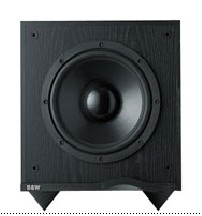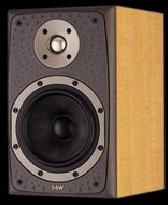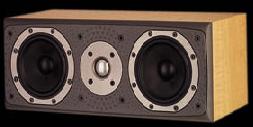Product Review - B&W Series 300
Compact 5.1 Speaker System - January, 2002
Michael James
![]()

|
DM303Type: Two-Way Vented-Box System. Dimensions: 13" x 8" x 9.5" Weight: 11 lbs. Response: 72Hz - 20kHz ± 3dB on ref axis Frequency Range: 6dB at 52Hz and 30kHz Sensitivity: 88dB spl (2.83V 1m) Nominal Impedance: 8 ohms (min 4.3 ohms) Power Handling: 25W - 100W into 8 ohms Drive Units: - 1 x 160mm (6") woven fibreglass cone bass/mid-range - 1 x 26mm (1") metal dome high-frequency Finish: Cabinet: Black Ash Vinyl, Maple Vinyl Grille: Black Cloth Suggested Retail: $300/pair LCR 3Description: 2 way vented-box system. Dimensions: 6" x 16.5" x 8.7" Net Weight: 11 lbs. Response: 80Hz - 20kHz ± 3dB on ref axis Frequency Range: -6dB at 60Hz and 30kHz Sensitivity: 90dB spl (2.83V 1m) Nominal Impedance: 8 ohms (min 3.3ohms) Power Handling : 25W - 100W into 8 ohms Drive Units: - 2 x 110mm (4.5") woven fibreglass cone bass/mid-range - 1 x 26mm (1") metal dome high-frequency Finish: Cabinet: Black Ash Vinyl, Maple Vinyl Grille: Black Cloth Suggested Retail: $220 ASW 500Description : Active vented-box subwoofer system Dimensions: 16.3" x 13.9" x 15.8 inches Net Weight : 26 lb. Response: ±3dB 32Hz - 80Hz Low-Pass Filter: Active 2nd-order at 80Hz High-Pass Filter: Passive 1st-order at 80 Hz Amplifier Power: 70W continuous Signal/Noise: 96dB Input Impedance: 22kohms Drive Units: 1 x 250mm (10in) dia long-throw with magnetic shielding Finish: Cabinet: Black Ash Vinyl Grille: Black Cloth Suggested Retail: $450
|
| B&W Speakers: http://www.bwspeakers.com |
Introduction
A quality home theater audio experience, within the spatial parameters of
average to smaller rooms, has become an increasingly louder consumer cry in
cities across America. Many newborn enthusiasts simply do not want their
living space to be overwhelmed by oversized and overcomplicated setups. Small
enclosures and competitive price tags are finding an ever increasing
demographic base. But are these restraints of size also at the expense of
performance?
Previous experience with compact or bookshelf 5.1 speaker systems, and the recent explosion of the all-in-one box home theater audio systems, have left a bad taste in my mouth, or more appropriately, a bad ringing in my ears. Some home theater speakers sized to fit the nouveaux petite shelves of designer wall units have a tendency to sound as if you were listening to the system within its own packing carton. This is not to imply that size
always determines sound quality. Some high-end speaker manufacturers are sizing down to meet this new audio challenge.
Some, however, need to be reminded not to extract quality while trying to economize on size. There are diamonds in the rough on the consumer audio shelves; it just takes a bit more task specific searching by the audio enthusiast. Being past smitten of B&W Nautilus test sessions, my audio spidey sense began tingling when hearing the news they
were entering the compact system foray.
The Goods
From the first minute of anticipation opening the packing carton, I was immediately cognizant of the trademark B&W build quality. Skeptics
envision corners being cut for profit margin, but this is not at all evident on
the B&W upon initial inspection. Do not misunderstand; these are still bookshelf speakers. You are not getting a set of Nautilus 805s here, but you are also not getting the average poorly assembled
products. The DM-303 bookshelf speaker weighs in at only eleven pounds, but feels a good deal more solid than eleven pounds. The internal bracing technology, wood-like
external appearance, and sturdy five-way speaker binding posts clearly differentiates this speaker from its bargain shelf competition. The maple vinyl grain, though not the same real wood finish as the Nautilus design, carries over that similar detail and feel of a master woodworkers shop.
Technologies of the Nautilus line have been employed within the DM-303 and LC-3 compact speakers. The signature tweeter section of the Nautilus line is near matched in performance within these models. A similar precise soundstage is achieved by using the tapering tube loading technology as was present in the original Nautilus tweeter. The highs do not have quite the same level of Nautilus openness, due in part, to the tweeter not being freed from the cabinet design. The DM-303 and LC-3 tweeter strive for that same precise and detailed Nautilus soundstage, and quite frankly, comes pleasingly close in performance. The dimpled patented B&W Flowport™ (similar to a golf ball's aerodynamics) is present in both the main speakers and the ASW-500 powered subwoofer. As in its bigger brothers, this airflow dynamics results in a significantly lower distortion level. Reducing turbulence at both ends of the port simply means less chuffing noise. All six pieces employing these design conformity makes for an acoustically mated combination.
The Performance
The DM-303 performance level exhibits itself as distinctive. The highs are clean and accurate, while the midrange is realistic and open, with no audible evidence of coloration. Both the tweeter and midrange drivers interact with a sonic cohesiveness of one, rather than of individual parts. Tweeter performance is smooth and silky with a liquid integration into the midrange region. Midrange is detailed with just the right amount of perspective. Too much midrange energy can make the audio presentation seem unpleasantly forward. Not enough midrange energy leaves the listener feeling distant from the performance. The DM-303 gives its audience a satisfying experience of being part of the presentation. Participation is neither fatiguing nor too far removed. When listening to the CD, "The Tales of 1001 Nights" by Renaissance, this liquid integration from highs to midrange levels
is exposed. For those not familiar, Renaissance is a 1970's group whose rhythmic arrangements combine classical symphonic orchestrations with original modern rock material. They are most clearly an album band, with their arrangements lasting upwards of ten minutes
each. Listening to this album with poor-performing equipment is not a very pleasant experience. They can seem overly bright and tiresome to the ear over the course of a ten-minute cut. I found none of this to be evident when auditioning this CD with the B&W setup. These speakers allowed
me to be swept away by the musical fantasy. Treble and midrange levels merge in such a delightful creamy manner, that the whole album will finish with the listener wanting more.
As I mentioned, small speaker systems can elicit the sensation of sound originating from within a box. The presentation of this system, gives one the much more desired sense of sound deriving from open space, rather than a fixed enclosure.
The bass performance in compact speakers is important in the sense of transition from bookshelf to subwoofer. Using a compact system that has little or no quality low bass performance, puts all the low bass performance responsibility on the subwoofer. The goal of a complete acoustic soundstage is furthered with a smooth shifting from speaker to subwoofer. This transition from bookshelf to sub needs be seamless, or else the audio illusion is broken. For compact speakers, I found the DM-303 and LC-3 to handle a solid share of low bass. This goes a long way in making the transition from speaker to sub seem flowing and liquid. In the DTS-DVD, "Courage Under Fire", sound effects need both be consistent between channels, as well as area specific. Obviously, the fact that you are using the same model fronts as rears goes a long way in accomplishing these goals. But, the quality integration alone does not furnish you with a completed task. The sound effects need resemble reality, in such a way, so you can experience the tension of the critical moments. This particular movie describes one incident through the varying interpretations of a number of characters. Each repeated scene depiction must be symmetrical to the previous sequence. Each repeated sequence must
also have the ability to expose small critical differences, to further expand the storyline. Speaker performance, which does not result in an accurate soundstage, not only muddles the effects, but will also muddle the storyline. The DM-303s not only furnish an excellent integrated speaker combination, but also do so in a detailed and accurate manner, so that the viewer is better able to decipher clues and facts along with the lead character. It provides for a much more enjoyable movie viewing experience when you need not pause the film and question your spouse on missed details.
Of course, the deep low bass level will not compare to full floor-standing models, but I was quite pleasantly surprised in the amount of bass these speakers could handle, and handle well. Would I go without a subwoofer? No, but
the B&W's low bass handling capability makes for a smoother transition and more unified acoustic soundstage.
 The LC-3 center channel does differentiate itself a bit from the other four
DM-303 speakers by having two 4.5-inch midrange drivers, as compared to a
single 6-inch driver. This makes for a very clear, precise, and articulate
center channel. Dialogue through the LC-3 is detailed and realistic, without
any unnatural chesty sounds. When watching the movie, "The Whole Nine Yards", I
noticed that the dialogue tone is quite distinctive between Bruce Willis, Mathew Perry, and Michael Clarke Duncan. When all three of these characters are speaking in rapid succession, lesser center channels show a tendency to spill these three voices into each other. This clearly is not the case for the LC-3 center channel. Each of these character's dialogue is articulate and distinctive.
The LC-3 center channel does differentiate itself a bit from the other four
DM-303 speakers by having two 4.5-inch midrange drivers, as compared to a
single 6-inch driver. This makes for a very clear, precise, and articulate
center channel. Dialogue through the LC-3 is detailed and realistic, without
any unnatural chesty sounds. When watching the movie, "The Whole Nine Yards", I
noticed that the dialogue tone is quite distinctive between Bruce Willis, Mathew Perry, and Michael Clarke Duncan. When all three of these characters are speaking in rapid succession, lesser center channels show a tendency to spill these three voices into each other. This clearly is not the case for the LC-3 center channel. Each of these character's dialogue is articulate and distinctive.
When evaluating center channel speaker performance, I have always found an excellent scale in the vocal tones of Sean Connery's voice. His dialogue inflection, with a poor executing center channel, can easily overemphasize a deep unnatural chesty sound. The final scene narration of the DVD, "Finding Forrester", gives the audience an excellent acoustic test. With the LC-3, his voice sounds quite natural and realistic in nature. Another adjunct examination is to audition his dialogue, as it volleys against another character. You want the vocal tone, to be that distinctive Connery inflection
of course, and not overhang or dominate into another characters timbre that
would otherwise make for a sloppy center channel output and an overall poor home theater experience. Again, the B&W LC-3 center handles this task in quite an excellent way.
The ASW-500 Subwoofer sports a 10-inch driver and 70 watts of amp power. This
unit seems perfectly matched to fill the acoustic gaps left by any low
frequency deficiencies of the other five speakers. For a relatively average
to small size subwoofer, this unit packs a solid effects punch. It handled
the plane crash sequence in "Cast Away" quite realistically, or at least as
realistic as I would ever want to experience. The helicopter acoustics in "Courage Under Fire", along with the automatic gunfire, made for a very suspenseful audio presentation. The ASW-500 can easily be daisy chained with a second unit, but to be perfectly honest, for average to small sized rooms, one is plenty. It is also fast enough and exhibits little overhang, so as to work
well with musical compositions. Recently, I was introduced to the works of a very talented musician, and two of his works called, "Phantom Moon" and "Humming". These two CDs of Duncan Sheik provide for a very interesting musical subwoofer challenge. The works combine a musical presentation, within the range of a gentle acoustic guitar and piano, accompanied with a fast visceral rhythmic percussion. A subwoofer must not only be accurate, in order to convey the realism of the percussion instruments,
but within these arrangements, it also needs to be fast enough, in order to keep a rhythmic pace. You want this pace to exhibit little evidence of overhang. Muddy speaker and sub performance
are the direct result of driver overhang. The ASW-500 performs this task quite admirably, giving the listener the feel of a personal in home concert session.
Personally, I have always emphasized the critical importance of both speaker
characteristic matching and proper positioning for a quality home
theater listening experience. Having five channels and subwoofer blend as
one complete soundstage is the much desired goal of any a 5.1 system.
Individual weaknesses can be magnified, and usually multiplied by
five, when there is little integration between speakers. Front, center, and
rear channels should be acoustically seamless, so that the soundtrack will
present as one complete entity. The dialogue channel, in order to be clear and realistic, needs the characteristics of speed and accuracy. Sometimes utilizing the exact same front and surround design will not always transfer over to a quality performing center channel. By designing the LC-3 center with two 4.5 inch midrange drivers, rather than making a carbon copy of DM-303, B&W obtains the goal of a more precise dialogue speaker. Plus, it is still quite capable of handling the many special effects that flow through the center channel,
thus meeting both goals of seamless integration and unit specific function. Having five equal basketball players at 5'-5" and 160 pounds will match seamlessly for the team picture, but will not likely translate into many team wins. A team,
that matches well, but also expands skills to overcome individual member deficiencies, will result in a higher level of productivity. The combination of the four bookshelf DM-303s, the LC-3 center, and the ASW-500 subwoofer make this B&W system work as a very productive team,
where each piece not only mates well with each other, but also carries a performance load, much higher as a whole, rather than the sum of its parts.
These six playback components sound excellent when placed around your viewing
environment. But, make the effort to correctly calibrate the speaker
positioning around the listening area, and performance level can rise to an
even more satisfying level. You will soon be ducking and covering for safety, while the realism of the rescue helicopters fly around your listening space. A performance level, strengthened by synchronicity of position, makes for a very pleasurable and complete audio soundstage.
Conclusion
In summary, I highly recommend this system be put near the top of your demo audition list. Quality bookshelf systems with a full transparent acoustic soundstage performance are not as numerous as the Sunday sale pages might indicate. Weigh all the performance, build quality, size, and cost level factors, and your choices narrow significantly. Let your ears make your final determination, and I feel you will be hard pressed to make a better compact system choice
than this one.
- Michael James -
![]()
© Copyright 2002 Secrets of Home Theater & High Fidelity
Return to Table of Contents for this Issue.




